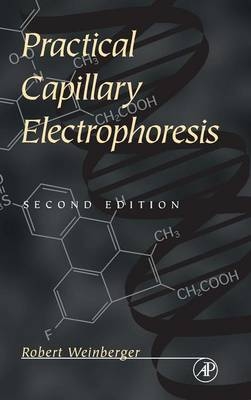
Practical Capillary Electrophoresis
Academic Press Inc (Verlag)
978-0-12-742356-2 (ISBN)
- Titel ist leider vergriffen;
keine Neuauflage - Artikel merken
In the 1980s, capillary electrophoresis (CE) joined high-performance liquid chromatography (HPLC) as the most powerful separation technique available to analytical chemists and biochemists. Published research using CE grew from 48 papers in the year of commercial introduction (1988) to 1200 in 1997. While only a dozen major pharmaceutical and biotech companies have reduced CE to routine practice, the applications market is showing real or potential growth in key areas, particularly in the DNA marketplace for genomic mapping and forensic identification. For drug development involving small molecules (including chiral separations), one CE instrument can replace 10 liquid chromatographs in terms of speed of analysis. CE also uses aqueous rather than organic solvents and is thus environmentally friendlier than HPLC. The second edition of Practical Capillary Electrophoresis has been extensively reorganized and rewritten to reflect modern usage in the field, with an emphasis on commercially available apparatus and reagents. This authoritative and very comprehensible treatment builds on the author's extensive experience as an instructor of short courses for the American Chemical Society and for industry.
Introduction. Electrophoresis. Micro-Chromatographic Separation Methods. Capillary Electrophoresis. Capillary Electrochromatography. Micromachined Electrophoretic Devices. Historical Perspective. Generic HPCE Systems. Instrumentation. Sources of information on HPCE. Capillary Electrophoresis-A Family of Techniques. Capillary Zone Electrophoresis-Basic Concepts. Electrical Conduction in Fluid Solution. The Language of Electrophoresis. Electroendoosmosis. Efficiency. Resolution. Joule Heating. Optimizing the Voltage and Temperature. Capillary Diameter and Buffer Ionic Strength. Optimizing the Capillary Length. Buffers. Temperature Effects. Buffer Additives. Capillaries. Sources of Bandbroadening. Capillary Zone Electrophoresis-Methods Development. Introduction. Mobility. Solute-Wall Interactions. Separation Strategies. Secondary Equilibrium. Applications and Techniques. Capillary Zone Electrophoresis-Secondary Equilibrium-Micelles, Cyclodextrins, and Related Reagents. Introduction. Micelles. Separation Mechanism. Selecting the Electrolyte System. Elution Range of MECC. Alternative Surfactant Systems. Cyclodextrins. Applications and Methods Development. Chiral Recognition. Capillary Isoelectric Focusing Basic Concepts. Separation Mechanism. pH Gradient Formation. Electrode Buffer Solutions. Resolving Power. Capillaries and Reagents. Performing a Run. Injection. Focusing. Mobilization. Salt Effects. Detection. Applicants. Size Separations in Capillary Gels and Polymer Networks. Introduction. Separation Mechanism. Materials for Size Separations. Size Separations with Non-Replaceable Polyacrylamide. Size Separations with Replaceable Agarose. Introduction to Polymer Networks. Operating Characteristics of Polymer Networks. Additional Materials for Polymer Networks. Applications and Methods Development. Reducing the Problem of Biased-Reptation. Capillary Electrochromatography. Introduction. Modes of CEC. Electroosmotic Flow in CEC. Efficiency of CEC. Operating Characteristics of Packed CEC. Applications. CEC Microfluidic Devices. Injection. Volumetric Constraints on Injection Size. Performing an Injection and Run. Injection Techniques. "Short-End" Injection. Injection Artifacts, Problems and Solutions. Stacking and Trace Enrichment. Detection. On-Capillary Detection. The Detection Problem. Limits of Detection. Detection Techniques. Bandbroadening. Absorption Detection. Fluorescence Detection. Derivatization. Mass Spectrometry. Micropreparative Fraction Collection. Putting it All Together. Selecting the Mode of HPCE. Requirements for Robust Separations. Realistic Compromises. Quantitative Analysis. Sample Preparation. Mobility as Qualitative Tool. Validation. Troubleshooting.
| Erscheint lt. Verlag | 18.4.2000 |
|---|---|
| Verlagsort | San Diego |
| Sprache | englisch |
| Maße | 152 x 229 mm |
| Gewicht | 740 g |
| Themenwelt | Naturwissenschaften ► Chemie ► Analytische Chemie |
| Naturwissenschaften ► Chemie ► Physikalische Chemie | |
| ISBN-10 | 0-12-742356-7 / 0127423567 |
| ISBN-13 | 978-0-12-742356-2 / 9780127423562 |
| Zustand | Neuware |
| Informationen gemäß Produktsicherheitsverordnung (GPSR) | |
| Haben Sie eine Frage zum Produkt? |
aus dem Bereich


